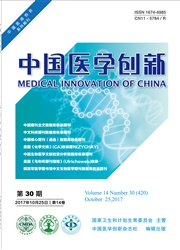

 中文摘要:
中文摘要:
目的:探讨健康教育联合自我护理行为干预对学龄期支气管哮喘儿童的应用价值。方法:选取本院儿科学龄期支气管哮喘儿童115例,采用随机数字表法将患儿分为两组,对照组57例,采用健康教育,观察组58例,在对照组患儿的基础上采用自我护理行为干预,比较两组患儿自我护理行为干预能力评分、哮喘控制程度与哮喘发作程度的差异。结果:护理后,观察组自我护理行为干预评分明显高于护理前与对照组(P〈0.05)。护理后,全部患儿哮喘完全控制率、哮喘部分控制与哮喘总体控制率明显高于护理前(P〈0.05);观察组哮喘完全控制率、哮喘部分控制与哮喘总体控制率均明显高于对照组(P〈0.05)。观察组哮喘发作次数、急诊次数与住院次数均明显少于对照组(P〈0.05)。结论:健康教育联合自我护理行为干预在改善学龄期支气管哮喘儿童自我护理行为干预能力、哮喘控制程度与哮喘发作程度中具有重要的应用价值,值得临床推广应用。
 英文摘要:
英文摘要:
Objective: To investigate the value of health education combined with self care behavior intervention for school aged children with asthma. Method: 115 school aged children with asthma in our hospital were selected and randomly divided into two groups, control group had 57 cases, were given health education, observation group had 58 cases, were given self care behavior intervention in the base of the control group, the differences of self care behavior intervention ability score, asthma control, asthma attacks between the two groups were compared. Result: After nursing, the self care behavior intervention scores of observation group were significantly higher than pre-nursing and control group ( P〈0.05 ) .After nursing, asthma total control rate, asthma partial control rate, asthma overall control rate of all children were significantly higher than pre- nursing ( P〈0.05 ) . The asthma total control rate, asthma partial control rate, asthma overall control rate of observation group were significantly higher than control group ( P〈0.05 ) . Asthma attacks amount, emergency visits amount and hospitalization amount of observation group were significantly less than control group ( P〈0.05 ). Conclusion: Health education combined with self care behavior intervention has important application value in improving self-care behavior, asthma control and asthma attacks for school aged children with asthma, it is worthy of clinical application.
 同期刊论文项目
同期刊论文项目
 同项目期刊论文
同项目期刊论文
 期刊信息
期刊信息
